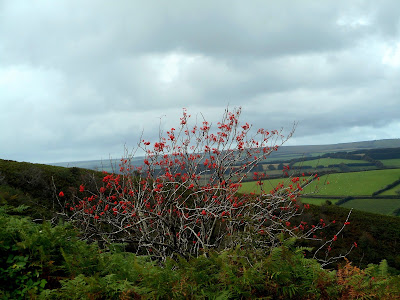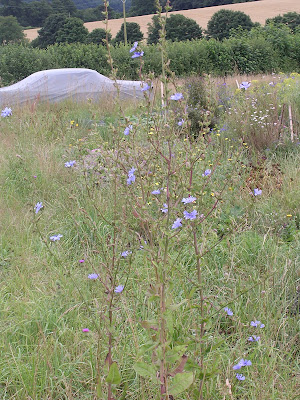 |
| Map extracted from Ordnance Survey Outdoor Leisure map 9 of Exmoor |
Our walks were becoming samey so we decided (sorry, I decided. Frog likes samey) to continue with our exploration of Exmoor. We’d been there quite a few times but had yet to find a walk we wanted to repeat. We decided (I decided) that we should head diagonally across the moor on a B road and stop at Winsford Hill, the first high point on the route.
We
had an additional reason for our expedition. One of my sisters and her daughter
had been to stay a couple of weeks earlier (much joy) and were going home (to Kent) via a
stop in North Devon. I directed them on to this very same road, saying that the
A road which goes round the moor wasn’t
exactly easy (lots of twists and turns which make me queasy) so they might as
well take the scenic route. My sister wrote afterwards that Exmoor looked
stunning but ‘the 1 in 4 gradients were tests of our driving skills and the car’s
brakes’. I felt a bit guilty and wanted to check out my advice, seeing as I couldn't remember when I'd last taken that road, or even if I ever had.
Dulverton
Dulverton on the edge of the moor was thronged with happy people in shorts and sandals. The town sits underneath steep wooded hills and always makes me think of Tolkien’s Rivendell. In winter it’s dark but today it was bathed in sunshine and I almost wished we were stopping for lunch. We’d decided however to take a picnic and not risk discovering that the eateries were still closed or imposing such stringent rules that visiting them was a penance.Winsford Hill
As we climbed out of the car at Winsford we were hit by a cold wind. Frog had sensibly brought a jumper but I shivered in my t-shirt and waterproof. We know that it’s always colder (and wetter and windier) on the moors but it’s hard to believe that when you’re basking in warmth at home.The Punchbowl
I’d seen interesting contours on the map and something called The Punchbowl and this was the first thing we encountered. It was impressive. Semi-circular, steep, not to say vertiginous, and matted with dark green trees and bushes. As I took out my camera, Ellie rushed to the edge to look over. |
| Ellie investigates The Punchbowl |
Nervously we called her back.
I was intrigued by orange blobs hanging
from what looked like dead branches. They were everywhere, hallucinogenic
against the lowering clouds.
 |
| What are these hallucinogenic orange blobs? |
I
realised that they were of course rowan berries, but where were the trees’
leaves? There were a few other species of tree around and they all had theirs. It
was exciting to see the rowans nonetheless as I only ever come across them on
the moors and they always feel a bit magical. We had tried to grow one at home
but it didn’t survive.
We
stopped to eat at a grassy circle under a stunted hawthorn: Frog’s horrible shop-bought
orange (red-pepper) hummus and my home-made stuff. For the first time, at the
insistence of my sister, I’d boiled by own chickpeas. The hummus was crunchy
and didn’t actually taste as nice as the stuff made with shop-cooked peas. I’d
obviously undercooked them. (Will I ever make a proper housewife?)
A
man in a Barbour walked past with three spaniels. He had the confidence of a local and I was hugely embarrassed when Ellie leapt out at his dogs, barking.
Already she’d staked out our picnic area as her territory. In spite of that, he
gave us a cheery ‘hello’.
There
were lots of people around, something that’s par for the course on the moors.
If I want solitude, I’m better off walking at home. Perhaps we don't go far
enough in, but I have to be careful not to worry Frog. Unlike me, he doesn’t like
adventures, and getting lost, and heading into the wilderness. He likes to know
in advance the exact route and how long it’s going to take. Strangely, in the
rest of his life he’s the opposite of that. (And perhaps I’m the other
way round.)
We
headed downhill through thick cover of low shrubs. The paths threaded through them like a maze and didn't bear much resemblance to the map. We took several wrong turnings and, even though he didn't say anything, I could see Frog becoming unhappy.
Ellie on the other hand, was going berserk, scooting
to and fro raising clouds of terrified pheasants.
‘Oh dear,’ I said, as their squawks echoed
round the walls of The Punchbowl. ‘I bet that man we saw is a shooter and the
birds are his.’
Reluctantly, we put her on a lead, and after she’d panted
painfully for a good five minutes we realised it was probably a good thing we'd had to slow her down. She is ten years old now, after all, roughly the same
age as us in dog terms and, like me, she’s extreme in her emotions and needs restricting
sometimes.
I looked disapprovingly at the bracken as I knew it was an invasive species and I thought about Sunday’s ‘Countryfile’ (on BBC1) in which a landowner in Suffolk who’s rewilding part of his estate explained that his wild-living pigs rooted out bracken with
their noses, a job which costs thousands of pounds if done by machine.
 |
| Bracken (and a bank of rowan) |
 |
| Pigs living wild at Knepp (and one of my brothers) |
That’s another thing about the moors. I can’t help seeing them as the semi-desert that they are, cleared of their trees by prehistoric humans in order to encourage deer which led to soil being washed away. They could recover however if we removed the grazing sheep. (Now I start to write about this, I realise how little I know. For more see Feral by George Monbiot, the father of rewilding. In the meantime I'll do some research.)
Heather, like bracken a moorland staple and a sign of its damaged ecosystem, is however gorgeous in flower. Most of it had gone
over but we did find one patch still blooming.
 |
| The gorgeous colour of heather in flower |
We headed back along a path that went round the inside of The Punchbowl, and the terrain wasn’t nearly as steep and scary as it looked from the top.
Even so, as
we neared the car Frog leant on his stick,
relieved to be returning to civilisation.
Thank
you, Frog, for coming with me on yet another walk/adventure!
*Back home, on Wikipedia, I found this about The Punchbowl : 'Given
the shape and orientation [north-east] of this deep hollow . . . it has been suggested that
it was the site of what may have been the only glacier on Exmoor and indeed in
southwest England during the Pleistocene ice ages.' And, if so, 'corrie' is the right word.























